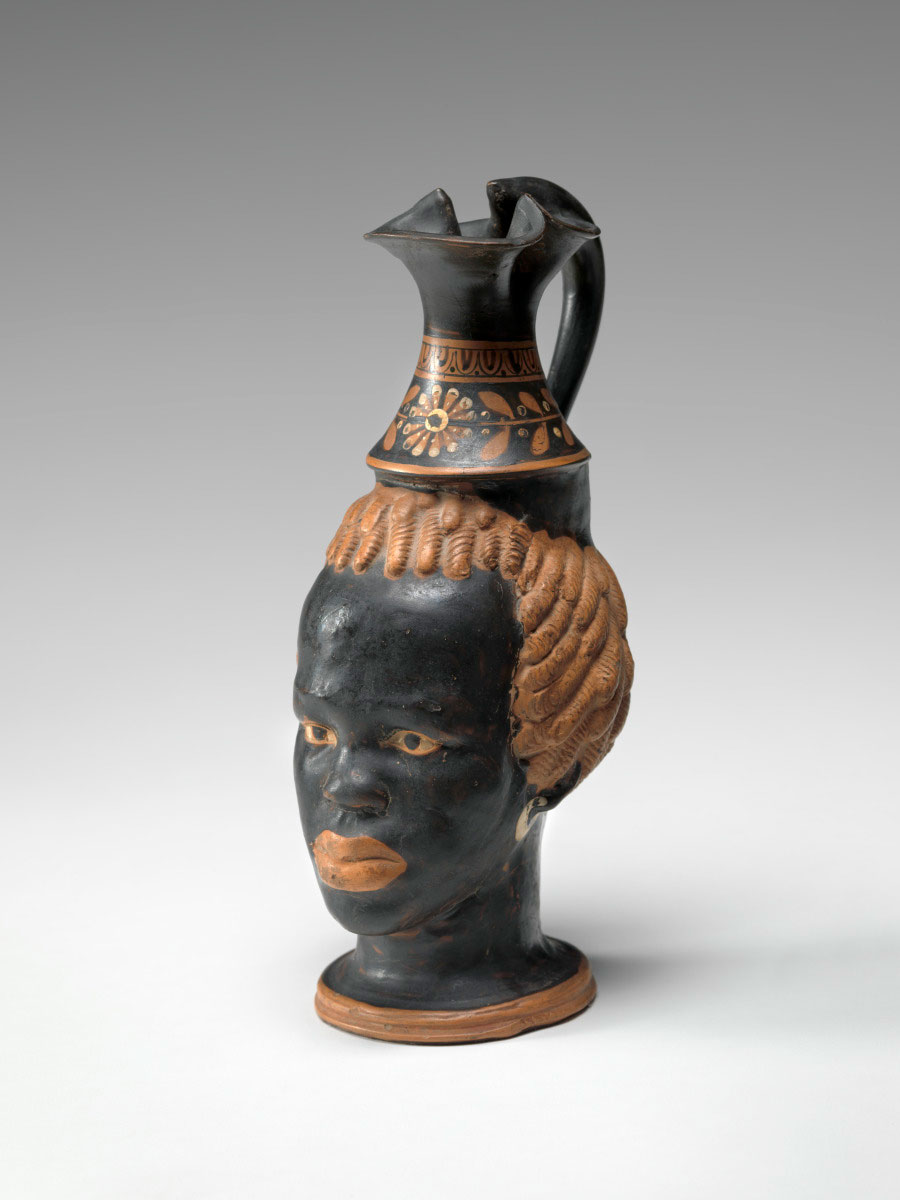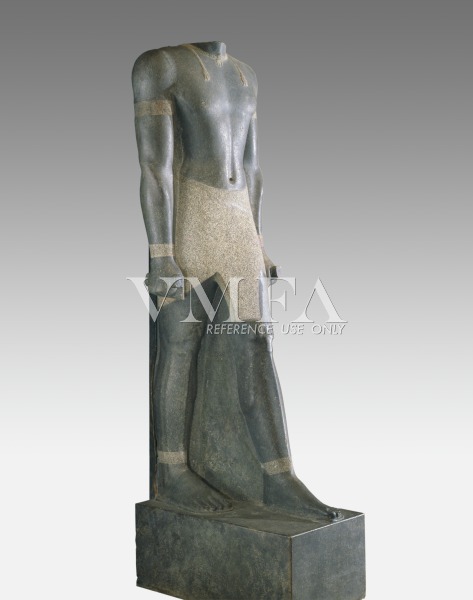Was “race” a concept in the ancient Greek and Roman world? That’s the question at the heart of a virtual talk organized and hosted by the Virginia Museum of Fine Arts. Presented as one of VMFA’s “3 in 30” gallery talks, which are currently offered virtually, the program brings together Dr. Peter Schertz, VMFA’s Jack and Mary Ann Frable Curator of Ancient Art, and Dr. Patrice Rankine, the University of Richmond’s Dean of the School of Arts and Sciences and a professor of Classics. In a conversation inspired by the VMFA exhibition Treasures of Ancient Egypt: Sunken Cities, which Schertz curated, the two will discuss the ancient Mediterranean world’s diversity as reflected in its art and literature. They will also consider the life and writings of Apuleius, who was of North African heritage. The virtual talk takes place on January 12, 2021; it’s free but requires registration.
Here, Paula Saylor-Robinson, VMFA’s Director of Audience Development and Community Outreach, joins Schertz and Rankine for a preview of their upcoming program and a discussion of how it came to be.

Paula Saylor-Robinson

Dr. Peter Schertz

Dr. Patrice Rankine
Saylor-Robinson:
What was the inspiration behind this conversation about race in the ancient world?
Schertz:
Part of the inspiration is Dr. Rankine’s prominence in the field of classical studies, the world of the Greeks and Romans, as well as his contributions to current discussions about the ways that the history of race and racism has distorted my field. I wanted to have a conversation with someone whose work I admire about one of the central issues our society faces, how to understand and overcome the legacy of racism. I also wanted to have this conversation because I think if people understand the diversity and complexity of the ancient Mediterranean, they’ll also understand that Western civilization has never just been about Europe and people we call Europeans—it is impossible to separate the Europe of two thousand years ago from the African and Asia of two thousand years ago. Selfishly, I just wanted to have a good conversation.
Saylor-Robinson:
In light of current issues about race and representation, how are ancient works of art being re-evaluated?
Schertz:
One of the most important discussions occurring across the museum world is a re-evaluation of the terms we use to describe art, including ancient Mediterranean art. I anticipate that the title of “Head Vase in the Shape of Nubian” [pictured below] will be changed to “Head Vase of a Black African” because we can’t be sure that the features are of a Nubian and because it is important to emphasize Africa is a vast continent with many peoples who have many different features. . . .
The Nubians lived in the Nile Valley to the south of Egypt in modern-day Sudan, and for many years, scholars used “Nubian” as a generic term for depictions of Black Africans in ancient Mediterranean art.

Red Figure Head Vase in the Shape of a Nubian, 350-320 BC, Greek (South Italian, Apulian),
terracotta, pigment. Virginia Museum of Fine Arts, Adolph D. and Wilkins C. Williams Fund
Saylor-Robinson:
Who was Apuleius? Tell us a little bit about what participants will learn in the upcoming talk.
Schertz:
Apuleius’s novel The Golden Ass is one of the funniest books I have ever read. Even if it’s nearly two thousand years old, the book is still hilarious. Apuleius is also a fascinating man. A North African who proudly declared that he was “half Numidian, half Gaetulian,” two tribes who lived in modern Algeria. Apuleius was born in the same city as the Christian theologian Saint Augustine, and both remind us how important the contributions of Africans were to the development of the Roman world and what we call Western civilization.
Saylor-Robinson:
Ancient civilizations were centered around the Mediterranean Sea and the contiguous continents. Will the talk address the intermingling of cultures there?
Schertz:
One of the most important take-aways from Sunken Cities is how interconnected the civilizations of the ancient Mediterranean were. Because parts of Europe, Asia, and Africa all border the Mediterranean Sea, the peoples of these continents were often in contact with one another because traveling over water was much easier and faster than traveling over land. This is also true of most waterways, so archaeologists have found beads from ancient Egypt in a tomb in Denmark as well as a statue made in India in the ruins of Pompeii in Italy.

Statue of Senkamanisken, King of Kush, 643–623 BC, Kushite (Nubian), gray-black granite.
Virginia Museum of Fine Arts, Adolph D. and Wilkins C. Williams Fund
Saylor-Robinson:
Was race a concept in the civilizations of Egypt, Greece or Rome? Was it the same as our current concept of race?
Schertz:
I am still learning about race in our time as well as race in the ancient Mediterranean world. In our time, race is most visibly expressed through skin color, and of course, people of different skin colors existed in the ancient Mediterranean world. People noticed skin color—that head vase [pictured previously] shows that some Greek artist living in Southern Italy 2300 years ago deliberately wanted to depict the facial features of a Black African. But it doesn’t seem as if skin color by itself defined anyone or was regarded as good or bad. More important to the ancient world, I think, was the concept of ethnicity, which defined a group of people by language, customs, and geographic origin. Dominant cultures often looked down upon the peoples they conquered. This is true for Greeks and Romans and also for Egyptians.
Rankine:
It’s worth saying that in no category I can think of is a concept the same today as it was in another time and place. Even with “democracy,” the word is the same, but it isn’t the same. In Athens in the 5th century BCE, democratic citizens were free-born Athenian males—that’s it. Even in America, democracy did not apply to women or African Americans until fairly recently in our history. In a similar way, there is clear evidence that the Greeks, for example, were quite ethnocentric. Herodotus’s histories from the 5th century BCE conveys a vision of the world with Greeks as the center, the perfect balance of all virtues. How they saw Persians, Africans, or any other category that we can examine betrays this ethnocentrism. They did not, however, have any category of race or racism that inheritors of the modern concept of “race” would recognize. Slaves in the ancient world, for example, could be any conquered people. From 1492 onward, the so-called New World brought new concepts. Race was one of those concepts. It is an artificial construct that justified the enslavement of Africans for cultural, religious, and quasi-biological reasons. It has been an incredibly pernicious, modern concept. There are scholars who argue for a kind of proto-racism in the ancient world, built on the ethnocentrism of the Greek or the Roman, but there is nothing of the system of racial-thinking that we see in the modern and contemporary worlds.
Saylor-Robinson:
How are we connected to the ancient world when it comes to modern-day concerns about identity, race, sexuality, and humanity in general?
Rankine
Well, where to begin on this one. Human beings are narrative-making entities. We know from psychology that we spend a great deal of mental energy making up stories about ourselves, and every story has a past, present, and future. We look to the past to understand—and even justify—who we are. This idea of democracy, demokratia, for example, has been with us since the late 6th century BCE. We find in the historian Thucydides in the 5th century a kind of grappling with what this “power in the interest of the people” is, what he at times calls isonomia, “equality under the law.” And here we are, coming out of the last four years, asking the following questions: Are we still a democracy in America? Is democracy sustainable? How fragile is it? This is a connection to the past, the legacy of democracy in Athens, as we understand it. But there are so many other connections. Many of my colleagues in the professional field of Classical Studies work on sexuality and gender because Greece and Rome provide other models for how we define and understand these terms. The modern binary was certainly not always the prevailing model. And I could go on. Slavery and freedom also come to mind. Greece and Rome were used both to justify slavery and to support emancipation, in the former case Thomas Dew, one-time president of William & Mary, comes to mind. He saw in Aristotle’s discussion of slavery a justification for enslavement of Black people. In the latter, Frederick Douglass saw in the ancients the exact opposite.
Saylor-Robinson:
What age-old human stories from the ancient world are still being played out today?
Rankine
The story of democracy is an age-old story that is still playing out today. Race also comes to mind. Race as a concept has a modern lineage, but we Americans are especially interested in where we might find traces of it in the ancient world. As narrative-making beings, it is natural that each group might wonder where in the past we might find traces of who we are today.
To join Peter Schertz and Patrice Rankine for their conversation on Tuesday, January 12, 2021, from 11 am to noon, register online. The program is free. Registration via Zoom is required. Learn more about VMFA’s upcoming virtual programs by visiting our website or subscribe to receive emails that deliver the latest VMFA news.